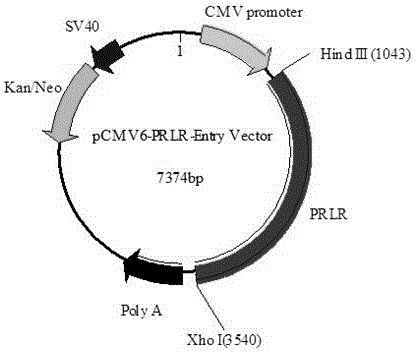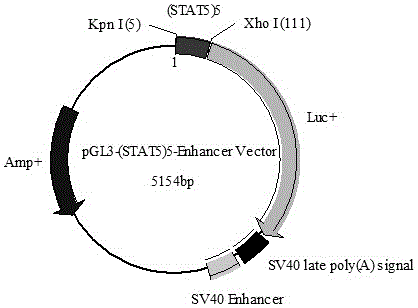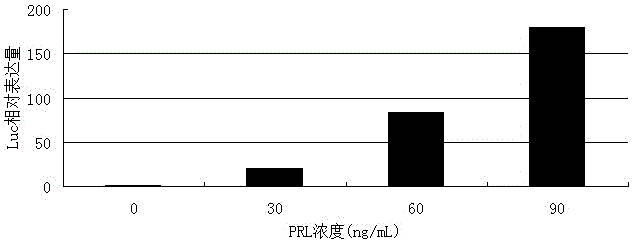Method for detecting fowl PRL based on JAK-STAT 5 signal transduction pathway
A JAK-STAT5, signal transduction technology, applied in the field of bioengineering, can solve problems such as high detection limit, data distortion, and environmental hazards, and achieve the effects of good stability and repeatability, low cost of use, and high sensitivity
- Summary
- Abstract
- Description
- Claims
- Application Information
AI Technical Summary
Problems solved by technology
Method used
Image
Examples
Embodiment 1
[0042] Example 1 Obtaining of Goose PRL R CDS Region Sequence
[0043] First take the goose pituitary tissue, after grinding with liquid nitrogen, use the TRIZol method to extract total RNA, and reverse transcribe it into cDNA; according to the goose PRLR sequence, the upstream primer PRLRf is designed by conventional methods as shown in SEQ ID No.1, and the downstream primer PRLRr sequence is shown in SEQ ID No. 2 shown;
[0044] Next, the CDS region of goose PRLR was amplified, and HindⅢ and XhoI restriction sites were introduced at the 5′ ends of the upstream and downstream primers. Using RT-PCR, the full-length 2496bp sequence of the CDS region of goose PRLR gene was obtained and carried out in genebank. Alignment (GeneID: DQ209271.2).
[0045] Finally, the obtained goose PRL receptor CDS region sequence was digested with HindⅢ and XhoI endonucleases, and (operated according to the instructions of the endonucleases) was ligated into the eukaryotic expression sequence that...
Embodiment 2
[0046] Example 2 Obtaining the STAT5 binding region sequence
[0047] According to the STAT5 binding sequence disclosed in the existing literature, it was synthesized by artificial synthesis, repeated 5 times, and two restriction sites KpnI and XhoI were introduced to obtain the sequence of the STAT5 binding region as shown in SEQIDNo.3.
[0048] The synthesized STAT5 binding region sequence was digested with KpnI and XhoI endonucleases, and then ligated into the eukaryotic expression vector pGL3-Enchancer (the reporter gene contained in the vector is fluorescent Sulfase gene), the sequence structure is constructed as figure 2 The indicated pGL3-STAT5 response vector.
Embodiment 3
[0049] The cell transfection of embodiment 3 transgenic vector and the stimulation of standard product PRL
[0050] The specific operation steps are as follows:
[0051](1) Human embryonic kidney 293T cells were added to modified DMEM medium and cultured at 37°C, 5% CO 2 Under the conditions, passaging once every 2-3 days, after culturing for 2 days, inoculate 293T cells in a 96-well plate, and when the cells grow to a confluence rate of 60%-70%, the pCMV6-PRLR constructed in Examples 1 and 2 The expression vector and pGL3-STAT5 response vector were transfected into cells with liposome LipofectamineLTX (the specific operation steps were carried out according to the instructions of the LipofectamineLTX kit), as the experimental group; the negative control group was transfected with eukaryotic expression vectors pCMV6-PRLR and pGL3-Enhancer ; With pRL-TK as the internal reference plasmid, 3 replicate wells were set for each group.
[0052] (2) Change the medium (improved DMEM ...
PUM
 Login to View More
Login to View More Abstract
Description
Claims
Application Information
 Login to View More
Login to View More - R&D
- Intellectual Property
- Life Sciences
- Materials
- Tech Scout
- Unparalleled Data Quality
- Higher Quality Content
- 60% Fewer Hallucinations
Browse by: Latest US Patents, China's latest patents, Technical Efficacy Thesaurus, Application Domain, Technology Topic, Popular Technical Reports.
© 2025 PatSnap. All rights reserved.Legal|Privacy policy|Modern Slavery Act Transparency Statement|Sitemap|About US| Contact US: help@patsnap.com



